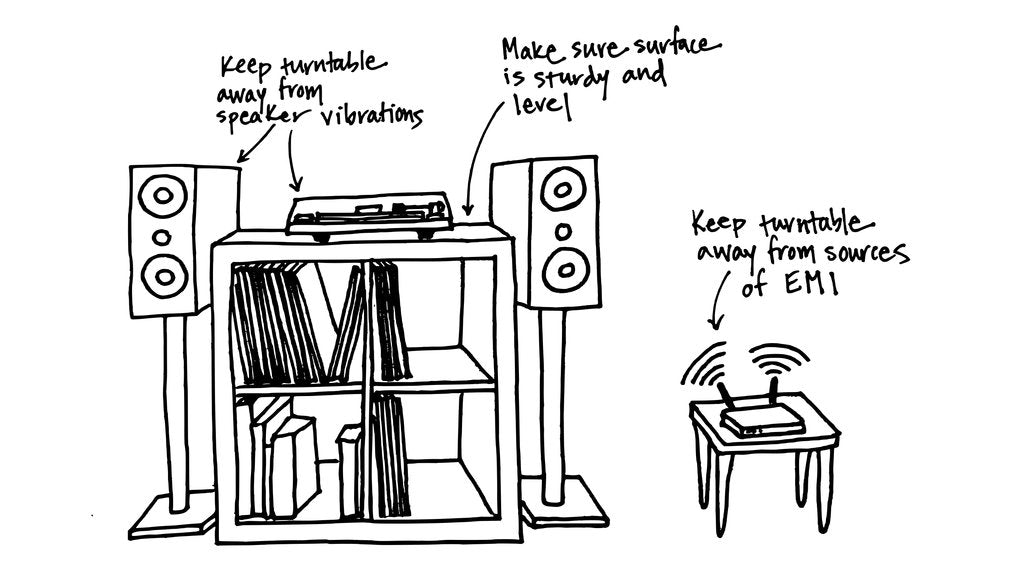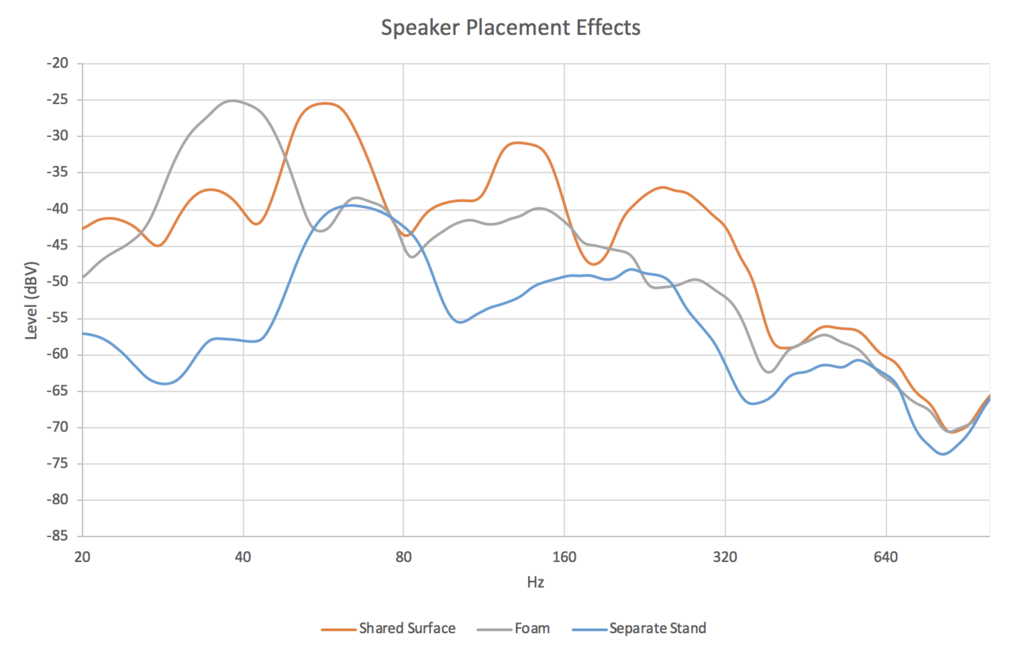How to position your turntable

- Speaker isolation. Place your turntable and your speakers on separate surfaces so that speaker vibrations don’t reach the turntable. And don't forget to position your speakers properly.
- Level the surface under your turntable. Keep your turntable level in order to prevent tracking issues and excess tonearm friction.
- Avoid interference. Isolate your turntable (especially the tonearm and cartridge) from sources of electrical noise such as amps, high power electronics, and anything with a wireless transmitter.
- Environmental factors. Keep your turntable in a climate-controlled indoor space.
Controlling speaker vibration
Put simply, your turntable's cartridge translates vibrations into sounds. For the cartridge to do its job properly, your turntable needs to be isolated from external sources of vibration, like speakers.
Speakers are typically the most significant source of vibration in a stereo system. If you hear feedback or distortion when you turn up the volume, then your speakers and turntable might not be sufficiently isolated from each other.
We recommend putting your speakers and turntable on entirely separate playing surfaces. Speaker stands are a great option (we're partial to these Sanus stands). If you're short on space, you can cheat a little by putting isolation pads under your speakers - this works best for small speakers being used at lower volume levels.
We cover speaker positioning in more detail here.
Visualizing the impact of vibration
We did an experiment to see the effects of speaker isolation. To do this, we played a range of audible frequencies through a speaker, and then measured how much vibration the turntable picked up from the speaker. We did this on three different setups (keeping volume and speaker-to-turntable distance the same for each):
- Speakers on the same surface as the turntable (shown below in orange)
- Speakers with foam isolation pads on the same surface as the turntable (gray)
- Speakers on separate floor stands next to the turntable (blue)

The x-axis of the chart shows the frequencies played through the speakers during the frequency sweep. The y-axis shows how much vibration the stylus picks up as noise any given frequency.
Unsurprisingly, keeping your speakers and turntable on separate surfaces reduces unwanted speaker vibrations at just about any frequency. The effects of vibration are most noticeable for the lower (bass) frequencies on the left side of the chart. This is because low frequency vibrations travel through materials more easily than high frequency vibrations. While foam isolation pads help a bit at medium and high frequencies, they aren't much of a help with lower frequencies
Isolation is even more important for subwoofers, since these boost the volume of low frequencies and extend the range of frequencies produced by your sound system. If you can feel the beat, then your turntable probably can too. Keep your sub as far away from your turntable as your setup will reasonably allow.
Choosing your playing surface
Setting your turntable on a heavy, stable piece of furniture will help isolate your turntable from all kinds of vibrations. The furniture's extra mass will absorb vibration so that your turntable doesn’t have to. Avoid surfaces that are light and rigid, since these surfaces may resonate at high volumes or shake when people walk by.
Your playing surface should be level. Otherwise, there will be excess horizontal force acting on the turntable. This excess force can increase friction in the turntable's bearings and can lead to tracking issues like distortion and skipping.
Preventing interference
The placement of your turntable can also help prevent electrical noise from creeping into playback.
-
What is interference? Interference presents itself as excess noise during playback - typically a buzz, hum, or static sound. Keep in mind that analog sources like turntables will never be dead quiet like digital audio sources. You will always hear some level of hum/buzz if you turn the volume up with no music playing (this is called the analog noise floor). But if you hear noise with music playing, then you should try to isolate your turntable from common sources of electrical noise.
-
How do I avoid it? Position the turntable at least a few feet away from electronic devices - especially high power electronics and devices with wireless transmitters. TVs, routers, cordless phones, and even light dimmers are common culprits. It's also important to make sure your RCA cables aren't running across/near power cables or adapters.
The transformers found in amps and powered speakers also emit noise - so there's another good reason to keep your turntable away from your powered speakers. Most stereo receivers have the transformer on the left side, so putting the turntable on the right side of the receiver is recommended. We strongly recommend not placing your turntable on top of your receiver - this can cause buzz issues and may also prevent your receiver from getting proper air flow.
Environmental considerations
Use common sense when finding a place for your turntable. In other words, keep it in a climate-controlled indoor space. Don't leave it outside or anywhere that it will be exposed to the elements. Ideally, temperature should be in the 65-75 °F range with relative humidity of roughly 30-50% (lower humidity can lead to static issues). Similar rules also apply when it comes to storing your records.